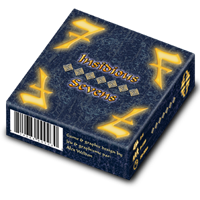Insidious Sevens was my first commercially published game. It’s a trick-taking game loosely based on the classic card game Oh Hell, which has been a family favorite for at least a couple of generations on my mother’s side. It made the GAMES Magazine Top 100 for 2012.
Insidious Sevens was born out of a desire to improve on Oh Hell, as despite my love for the game, it has many flaws that were apparent to me long before I started thinking of game design as a career. Although I started thinking about ways to refine the rules while still using a standard deck of cards, certain ideas led me to think it would be easier to work with a different distribution of cards, which in turn led to the decision to try to get it published commercially. The deck I settled on contains the numbers 0-7 in each of 5 colors, for a total of 40 cards.
Like Oh Hell and many other games in the genre, the basic goal of Insidious Sevens is to predict how many tricks you’ll win in each hand. You earn points for being exactly right, and lose points for being wrong, regardless of whether you take too many or too few.
Each of the game’s seven hands begins with each player being dealt seven cards; the entire deck is not dealt out, even with 5 players, so exact card-counting is impossible, and the number of cards per hand is constant, so each hand is equally important. After receiving their cards, players pass cards, except on the first and last hands, which are “keepers.” This is a mechanic borrowed from Hearts, another game I’m very fond of. The number of cards passed and the direction changes from hand to hand.
Next comes the bidding phase, which is the main area of innovation in Insidious Sevens. Rather than bidding sequentially and verbally, players bid simultaneously, using a card from their hand. This is the reason the values of the cards range between 0 and 7, and has the result that players may not always be able to bid exactly what they want. Aside from adding an extra consideration to the passing phase, this limitation forces players away from sticking to a single strategy and obliges them to make the best of the hand they’re dealt. The simultaneous bidding also means that dramatically over- and under-bid hands are bound to occur, even with a conservative group of players.
The highest card used in bidding determines both the trump color and the starting player. From there, play proceeds much like a standard trick-taking game, with the winner of each trick leading the next, players being obliged to follow the lead, and the highest following card winning the trick, unless trumped. The main twist here is that players may follow either number or color, increasing the tactical complexity of the hand. Low-colored 7s are unlikely to win if led, for instance, as higher 7s can be played on them, and a trump may be played at any time if it matches the number of the card led.
The scoring is also geared more aggressively than most games in the genre, with only 2 points being awarded for a correct bid, plus one per trick; thus, a successful bid of 5 is worth more than even three successful bids of 0, offering an incentive for players to bid high. Combined with the relatively small number of hands, this eliminates the common problem of one player being too far ahead to catch; it’s rare for the winner in Insidious Sevens to be conclusively decided before the last trick is played out.
